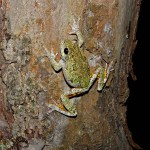Why Garden Frogs and Toads are Beneficial
1) First and foremost: Frogs and toads eat a LOT of insects. One individual can eat as many as 10,000 insects in a season. They do their eating at night so they are not bothered by your gardening chores. Get rid of your ants, mosquitoes and their larvae, sow bugs, flies, earwigs, slugs, cucumber beetles, caterpillars, grasshoppers, cutworms, and pill bugs. Turn them into fertilizer through the stomachs of garden frogs and toads.
2) Garden frogs and toads are interesting, benign, and fun creatures. Children and adults love them. However, they do have some nasty chemical compounds on their skin, so if you handle them, please wash your hands afterward, and keep your hands away from your face or mouth until you do.
3) Their songs help to thaw out our frozen bones after a hard winter. Can you imagine camping out in the Spring and not hearing lots of frogs and toads calling for their mates? That would truly be an alarming “silent spring.”
4) Garden frogs and toads are environmental indicators. They spend part of their life cycles in water and part on land. They absorb moisture and oxygen through their permeable skins. If there is something amiss with the environment, you will notice the consequences sooner with frogs and toads than with your own symptoms. So if you have lots of frogs and toads around, your water and air are pretty good.
How to Attract Garden Frogs and Toads
1) Garden frogs and toads need three things: shelter, water, and something to eat (insects).
2) They need hiding places: shrubs, logs, piles of rocks, leaf litter, toad houses, a pond.
About toad houses: You can buy great looking, decorative toad houses, but you might not want to put them in your garden for toads. Try turning a terracotta flower pot upside down with a door broken out of the side. Or dig a trench and lay a log on top of it with an entrance at each end. Be sure to place it under a shrub or other shade to keep it cool in the Summer. Make sure your toad house is open on the bottom and the entry is big enough (4 inches will do).
3) They need hibernating places: leaf litter, ponds, burrows. Some frogs hibernate at the bottom of a pond and shut down their systems until Spring.
About leaf litter: Don’t be too quick to rake up all your leaves in the Fall. Many animals, including frogs and toads, use piles of leaves for protection in the Winter. When they stir in the Spring there will be lots of bugs to eat in the leaf litter.
4) They need water: Frogs need to be near ponds year round. Toads need ponds during the mating season. Here are some hints about building a frog/toad pond:
- Make it deep enough so it won’t freeze solid in the Winter (18 inches or more).
- Frogs and toads like still water, so use a minimum fountain or no fountain.
- The tadpoles will keep your pond clean of algae.
- Frogs and toads will keep it clean of mosquitoes and larvae.
How to keep them Healthy
1) Avoid using pesticides, herbicides, and fungicides. Use natural plantings that are hardy without chemical help.
2) Keep grass around the pond cut short. Frogs and toads will hide in long grass so you cannot see them, and then will not survive a mower blade.
3) Don’t put fish in your pond. Fish will eat tadpoles.
4) Provide places to bask and hide. How about laying a log part in, part out of the pond. A pile of rocks is a great place to sun bath and hide if necessary.
5) If you use mesh to cover some of your garden crops: Use a mesh with 1 1/2″ square holes or greater to keep the frogs and toads from getting entangled.
6) Domestic pets: Do your best to keep your dog and cat separate from your garden frogs and toads.
Timing Considerations
Mrs. Frog says, “If you build it, they will come.” Give the garden frogs and toads in your neighborhood time to populate your little piece of paradise naturally.
Don’t try to capture frogs and toads elsewhere and bring them to your place - they will probably either try to migrate back home or possibly die.
And DON’T buy frogs or toads from a pet store and introduce them to your garden. They are not native creatures. They will become an invasive species and disrupt the natural balance of your local ecosystem.
It may take a couple of seasons for your garden frog and toad population to balance out, but you will be glad for the effort you put in to attract them.

